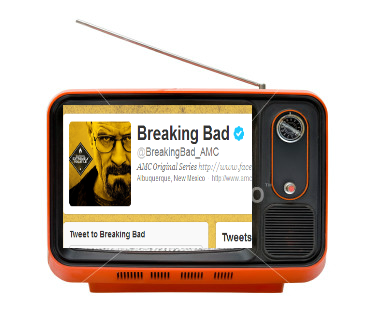Guest Post by Vicky Anscombe
 Ever since the birth of the ‘Tweetbreak’ (you know, when during the ads, hordes of outraged/delighted/bemused/horrified Twitter users take to their accounts to make their voices heard), the link between TV and social media has been undeniable.
Ever since the birth of the ‘Tweetbreak’ (you know, when during the ads, hordes of outraged/delighted/bemused/horrified Twitter users take to their accounts to make their voices heard), the link between TV and social media has been undeniable.
I suppose it really hit home when at the beginning of UK-based Channel 4 programme ‘One Born Every Minute’, the hashtag ‘#oneborn’ was displayed. Programme makers, especially those whose shows are shown during the peak of wine-swilling, dinner-digesting, children-free prime time, know that people will want to talk about what they see. TV and Social Media are currently embroiled in a torrid love-affair; but how long will it last for?
The honest answer is, from what I can see, indefinitely. TV and Social Media’s symbiotic relationship is something that most consumers find irresistible – it’s quick, it’s easy, it’s a great way to find out what other people are thinking, and you can be a part of a country – or global-wide conversation in seconds.
When I ran the social media accounts for a news programme in the East of England, one of the first lessons I learned was that TV isn’t the all-seeing, all-knowing behemoth it once was thought to be. People aren’t mindless consumers, passively drinking in whatever the television tells them.
These days…
Social media is a tool used for conversations that are two-way and, hopefully, mutually beneficial. The programme’s Twitter account was used for getting breaking news out to our audience as soon as possible, but we also relied upon our followers to report any breaking news to us. A quick response was vital, as was keeping a close eye on the Twitter account at all times – even at weekends. People became accustomed to us being available and ready to reply within minutes, which, considering the nature of the programme, was to be expected.
Another lesson I learned was that audiences vary; what may be suitable for one platform isn’t suitable for another. The programme’s Twitter account played host to a variety of content: stories of a sensitive nature, traffic news, appeals for eyewitnesses and photo content, travel news and breaking news from legal proceedings.
The Twitter audience used our feed purely as a form of news; not something to be commented on, most of the time. However, the Facebook audience was entirely different. These people clearly took a great deal of pride in their location, and their relationship with the programme; they wanted to discuss news items, share their stories with journalists, make enquiries about the programme and praise the presenters. This also meant that, unfortunately, content had to be monitored as a ‘mob mentality’ could develop if stories were published about topics such as: gypsies, illegal immigrants, abortion, paedophiles or murderers.
Advice…
I would advise any news channel using Facebook to limit the stories it publishes about sensitive subjects; try not to think of it as ‘dumbing down’ – just limiting Facebook to ‘the lighter side of life’. You’d be surprised what kind of tasteless discussions can develop over a lunch-hour – and the amount of people that feel the need to get involved in such a debate. However, we chose just to remove abusive posts – not block users, unless they were repeat offenders. We also kept all comments about the programme on the Facebook wall, whether they were good or bad – journalists, as a rule, try their hardest to avoid censorship. It would have been hypocritical of us to exercise it across our social media.
Finally, try to remember that your audience want to be a part of the programme, and are often delighted to help the journalists they have a relationship with, but there is a fine line between ‘keen to find news’ and ‘downright insensitive’. A London-based news channel recently enraged its Facebook fans when, not soon after the cruise ship Costa Concordia capsized, they asked for photos and videos of the disaster. The fact they then chose to substantiate this update with the phrase ‘We feel it is our duty to report on this’ resulted in hundreds of disgusted fans mocking their tactless approach, which is hardly surprising.

Vicky Anscombe is an Online PR and Social Media Consultant at Further. Follow her on Twitter.

